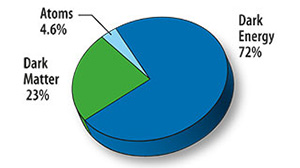“What really impressed me was the trip down,” said astrophysicist James Buckley, PhD, speaking of the vertical mile he traveled to get to the site of an underground dark-matter experiment. “You can see you’re moving at a pretty good clip, which, by the way, is three times slower than the cage used to drop when it was a mine. It took us 10 minutes to get down a mile. You just watch the earth flashing by and every once in a while you go past a boarded up tunnel.”
The mine is the Homestake Mine, a played-out gold mine in Lead, S.D., that has been converted into a warren of underground chambers housing physics experiments that need to be shielded from cosmic radiation.
One of these experiments is the Lux detector, designed to detect WIMPs (weakly interacting massive particles). WIMPs are hypothetical subatomic particles thought to make up dark matter in much the same way that electrons and quarks make up ordinary matter. But compared to other particles, WIMPs are elusive and interact only rarely with ordinary matter, and so far Lux hasn’t found any.

Buckley, a professor of physics in Arts & Sciences at Washington University in St. Louis, is a co-investigator on a team building a supersized version of Lux, called Lux-Zeplin, that will be roughly 100 times more sensitive to dark matter than its predecessor. Lux-Zeplin and two other dark-matter experiments survived a stringent “downselection” of competing dark-matter experiments and received Department of Energy and the National Science Foundation funding this July.
An enormous vat of xenon
The problem with finding WIMPs is not that they are rare, but that they rarely interact with ordinary matter. “A billion dark matter particles go through you every second, but you’d have to wait a thousand years for one of them to interact with you,” Buckley said.
The detector is essentially a huge vat of liquid xenon, a meter and a half tall and a meter and a half across.” The idea is that rare collisions between WIMPs and the nuclei of the xenon atoms will leave detectable signatures in the form of sequential light signals (see illustration below).

Xenon is present in Earth’s atmosphere as a trace gas, but only at a level of about one part per 11.5 million. Usable amounts of xenon are produced as a byproduct of the separation of oxygen and nitrogen in liquid air. The liquid oxygen contains small quantities of krypton and xenon, which can in turn be separated and concentrated by further processing.
Because it is rare, xenon is pricey. The new detector calls for a million liters of it, which Buckley calculates is 20 percent of the world’s annual production of xenon. In 1999 a liter of xenon cost $15, so the cost of filling Lux-Zeplin back then would have been $15 million.
But the price has since spiked because of the popularity of xenon halogen lighting. The physicists hope LEDs will make sufficient inroads in the lighting market to bring it down again before they have to place their order.
The hunting of the WIMP: an agony in many fits
To a layperson Lux-Zeplin sounds like a foolproof WIMP trap, but Buckley knows it is a gamble. “I actually would be surprised if any of the dark matter experiments now running reveal a strong signal,” he said.
Why so pessimistic? Well, the first thing to realize is that even though physicists are certain dark-matter exists, they don’t know exactly what it is. So when they back a dark-matter experiment, they are in effect placing a bet.
Even if the Lux-Zeplin team guessed the particle’s mass correctly and matched it correctly with xenon, they still have to detect very rare events—roughly one nuclear recoil every several years—hidden among many light-producing interactions among bits of ordinary matter.
To make the signal pop they’ve done everything they can to suppress the background. The detector is located deep underground to block out cosmic rays. The tanks are made of “quiet” materials so they don’t themselves become of the source of light flashes. And the detector is wrapped in a water jacket with its own photomultiplier tubes so non-WIMP particles that ionize water can be rejected as background.
The xenon tank is being supersized to unmask neutrons, one of the subtler WIMP pretenders. There will be enough xenon in the bigger tank that a neutron would probably interact twice within its volume, whereas the shyer WIMP would only interact once.
Even so it’s going to come down to statistics and levels of confidence, Buckley said. “Previous experiments of this type all saw a few events right near a threshold and the teams were hard pressed to convince anyone they weren’t just background,” he said.
This is why Buckley, who was part of a recent long-term planning exercise for the high-energy physics community, feels that physicists should sneak up on dark matter from several different directions at once. “You can either see itwith these deep underground detectors that look for flashes of light or you can turn gamma-ray telescopes on the center of galaxies where the dark matter is most concentrated and look for the dark matter to annihilate into gamma rays.”
The two techniques, called direct detection and indirect detection, have complementary strengths and weaknesses, Buckley said.
The heart of darkness
So what is dark matter? “The stuff we’re used to—planets, stars, interstellar gas clouds and the rest of it—makes up only a tiny wedge in a pie of the entire matter-energy content of the universe,” Buckley said. “The bulk of the universe is in the dark sector, in an unknown dark form.”

“Gravitationally, at least, darkmatter behaves like other matter,” Buckley said.“In fact we know that it exists because of its gravitational impact on the orbits of stars in galaxies and the relative motion of galaxies.”
The first hints that something else was out there came from galaxies behaving strangely. The stars and gas on the outskirts of galaxies should move more slowly than those near the center, but astronomers noticed that in some galaxies the outer stars were moving as quickly as those at the center. They concluded that the attraction of unseen matter was holding the outer stars in the galaxy, preventing them from being flung outward despite their speed.
At first the scientists wondered if they had just gotten the law of gravity slightly wrong. But then they began to notice effects that couldn’t be explained by modified gravity.
Dark matter neither emits nor absorbs light but it can still be “seen” through an effect called gravitational lensing. Because massive objects distort space-time, light from distant galaxies bends around dark-matter clusters, so that the galaxies appear to a viewer to be rings or arc segments rather than point sources.
This effect made it possible to capture a spectacular image of dark matter in something called the bullet cluster. The image (below) shows two galaxy clusters that collided and passed through one another. The ordinary matter clumped together at the center, but the dark matter passed right through the collision and ended up on either side of the ordinary matter.
“In this galaxy,” Buckley said, “dark-matter is in one place and ordinary matter (in the form of interstellar gas) is in another. This meant that it wasn’t that we got the law of gravity wrong on large distance scales; dark-matter had to be something like an unknown particle.”

“So at this point the evidence is that there’s unseen dark-matter and it looks like particles,” Buckley said, “and there’s a beautiful argument for thinking dark matter consists of weakly interacting dark particles.”
“That idea,” he says, “really started with Ram Cowsik in our department. He co-authored a seminal paper that said that weakly interacting particles would fall out of equilibrium very early in the history of the universe. If they decoupled early, they’d be protected and form a relict population that would persist until today.”
“The argument was that the weak survive. The more weakly interacting a particle, the bigger its relict density, and Ram argued that particles that dropped out early would naturally give us the mass density we see in the universe today.”
“That, in a nutshell, is why we’re looking for WIMPs in the Homestake mine,” Buckley said.
Black on black
Exciting as all of this is, there’s no getting around the fact that for most of human history astronomers have concentrated on only 4 percent of the universe, in blissful ignorance of the rest. That’s enough to make anyone wonder about the limits of human understanding.
Maybe that’s why Buckley, who as an astrophysicist has spent his working life asking very big questions about nature and life, sometimes says things that sound more philosophical than scientific.
Commenting on the odds of finding dark-matter with Lux-Zeplin, he said, “ What if dark matter just interacts so weakly with ordinary matter that we’ll never see it in an experiment?” he asked. “That’s kind of cool.
“After all, where is it written that everything should be understandable? We believe there’s a contract that says human beings will eventually be able to understand everything, but what if that’s not true?”
And then he brings up the dreaded “second wedge” of the dark sector – the dark energy. If possible, dark energy is even less comprehensible than dark-matter. “Dark-matter at least behaves like other matter gravitationally,” he said. “But dark energy doesn’t even do that; it repulses rather than attracts other matter.”
“If the current understanding of dark energy is right,” he continued, “the universe is going to be expanding so fast that the more distant galaxies are going to disappear from our view and we’ll have less and less information about the universe,” Buckley said.
“We’ve been very lucky so far that we’ve been able to learn so much about the stars,” he said. “We were born in a time when we can see further out than we’ll be able to see in the future, in a time when we can actually learn more.”